Hyundai Santa Fe vs Kia EV9 – erot ja hinnat vertailussa
Kustannukset ja kulutus
Hinnan ja tehokkuuden vertailussa erot tulevat usein selvimmin esiin. Tässä ratkaistaan, kumpi malli sopii paremmin budjettiisi pitkällä aikavälillä.
Hyundai Santa Fe on hinnassa kevyt edullisempi – sen lähtöhinta on 59800 €, kun taas Kia EV9 maksaa 62000 €. Ero on noin 2240 €.
Toimintamatkassa Kia EV9 suoriutuu selvä paremmin: se yltää jopa 563 km:een, noin 509 km enemmän kuin Hyundai Santa Fe.
Moottori ja suorituskyky
Moottorin alta paljastuu, kumpi malli on urheilullisempi ja kiihtyy paremmin.
Moottoritehossa Kia EV9 on merkittävä etulyöntiasemassa – 508 hv verrattuna 253 hv:een. Ero on noin 255 hv hv.
Kiihdytyksessä 0–100 km/h Kia EV9 on selvä nopeampi – se saavuttaa 100 km/h ajassa 4.60 s, kun taas Hyundai Santa Fe tarvitsee 9 s. Ero on noin 4.40 s sekuntia.
Huippunopeudessa Kia EV9 on pienessä määrin edellä – se yltää 220 km/h:een, kun taas Hyundai Santa Fe saavuttaa 196 km/h. Ero on noin 24 km/h.
Myös vääntömomentissa näkyy ero: Kia EV9 vetää selvä voimakkaammin, 740 Nm verrattuna 380 Nm:een. Eroa on noin 360 Nm.
Tila ja käytännöllisyys
Tehon ohella arjessa ratkaisevat mukavuus ja käytännöllisyys. Tässä selviää, kumpi auto on monipuolisempi ja tilavampi.
Istuimet: tarjoaa enemmän istumapaikkoja – vs. .
Omapainossa Hyundai Santa Fe on selvästi havaittava kevyempi – 1920 kg verrattuna 2392 kg:een. Painoero on noin 472 kg.
Tavaratilan koossa Hyundai Santa Fe tarjoaa selvä enemmän – 711 L verrattuna 333 L:een. Ero on noin 378 L.
Maksimikantavuudessa Kia EV9 pärjää hieman paremmin – jopa 2393 L, noin 361 L enemmän kuin Hyundai Santa Fe.
Kantavuudessa Hyundai Santa Fe on kevyt parempi – 665 kg verrattuna 615 kg:een. Ero on noin 50 kg.
Kuka vie voiton?
Kokonaisuudessaan Kia EV9 on on ylivoimainen ja nappaa näin DriveDuel Champion -tittelin.
Se vakuuttaa tasapainoisemmalla kokonaisuudellaan ja on käytännöllisempi kumppani arjessa.
 @ Kia Corporation
@ Kia Corporation
Kia EV9
Kustannukset ja kulutus
Näytä yksityiskohtainen analyysi
Moottori ja suorituskyky
Näytä yksityiskohtainen analyysi
Mitat ja kori
Näytä yksityiskohtainen analyysi
Hyundai Santa Fe
Santa Fe on tilava ja rauhallinen katumaasturi, joka tekee arkisesta matkanteosta vaivatonta ja mukavaa — selkeä valinta erityisesti perheille ja pidempiä matkoja ajaville. Se ei yritä olla urheiluauto, vaan panostaa käytännöllisyyteen, turvallisuuteen ja hillittyyn tyylikkyyteen, eli juuri sitä mitä moni ostaja toivoo.
Tiedot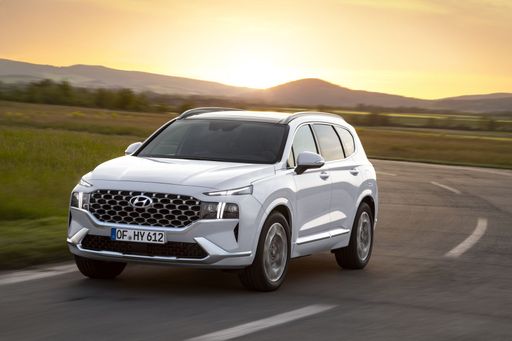 @ Hyundai Motor Company
@ Hyundai Motor Company
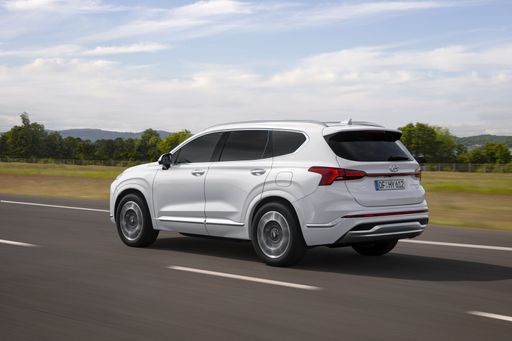 @ Hyundai Motor Company
@ Hyundai Motor Company
 @ Hyundai Motor Company
@ Hyundai Motor Company
 @ Hyundai Motor Company
@ Hyundai Motor Company
 @ Hyundai Motor Company
@ Hyundai Motor Company
Kia EV9
Kia EV9 on massiivinen ja näyttävä sähköinen katumaasturi, joka vakuuttaa futuristisella muotoilullaan, avaralla ja monikäyttöisellä sisustallaan sekä laadukkailla materiaaleilla. Ajossa se on rauhallinen ja vaivaton, joten se sopii mainiosti pidemmillekin matkoille ja arjen touhuihin — se tekee sähköautoon vaihtamisesta astetta tyylikkäämmän ja hauskemman kokemuksen.
Tiedot @ Kia Corporation
@ Kia Corporation
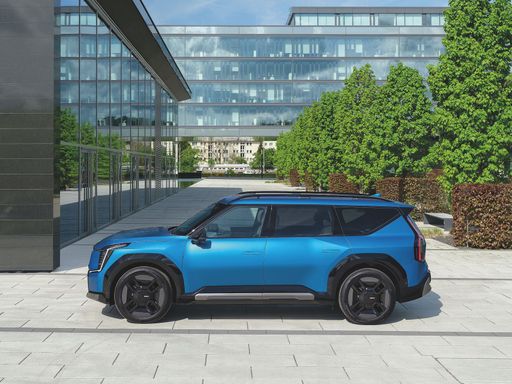 @ Kia Corporation
@ Kia Corporation
 @ Kia Corporation
@ Kia Corporation
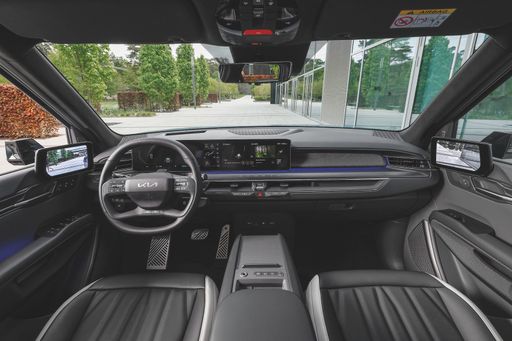 @ Kia Corporation
@ Kia Corporation
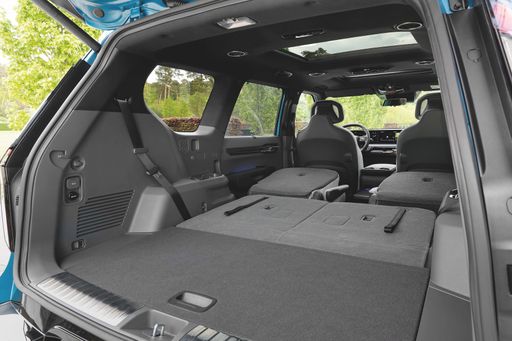 @ Kia Corporation
@ Kia Corporation
 @ Hyundai Motor Company
@ Hyundai Motor Company
|
 @ Kia Corporation
@ Kia Corporation
|
|
|
|
Kustannukset ja kulutus |
|
|---|---|
|
Hinta
59800 - 68200 €
|
Hinta
62000 - 91000 €
|
|
Kulutus L/100km
1.7 - 7.1 L
|
Kulutus L/100km
-
|
|
Kulutus kWh/100km
-
|
Kulutus kWh/100km
19.5 - 22.8 kWh
|
|
Sähköinen toimintasäde
54 km
|
Sähköinen toimintasäde
443 - 563 km
|
|
Akun kapasiteetti
-
|
Akun kapasiteetti
76.1 - 99.8 kWh
|
|
CO2
38 - 160 g/km
|
CO2
0 g/km
|
|
Polttoainesäiliön tilavuus
47 - 67 L
|
Polttoainesäiliön tilavuus
-
|
Mitat ja kori |
|
|---|---|
|
Kori
SUV
|
Kori
SUV
|
|
Istuimet
5 - 7
|
Istuimet
6 - 7
|
|
Ovet
5
|
Ovet
5
|
|
Omamassa
1920 - 2165 kg
|
Omamassa
2392 - 2664 kg
|
|
Tavaratila
621 - 711 L
|
Tavaratila
333 L
|
|
Pituus
4830 mm
|
Pituus
5010 - 5015 mm
|
|
Leveys
1900 mm
|
Leveys
1980 mm
|
|
Korkeus
1720 mm
|
Korkeus
1755 - 1780 mm
|
|
Maksimi tavaratila
1942 - 2032 L
|
Maksimi tavaratila
2318 - 2393 L
|
|
Kantavuus
560 - 665 kg
|
Kantavuus
542 - 615 kg
|
Moottori ja suorituskyky |
|
|---|---|
|
Moottorityyppi
Plug-in hybridi, Täyshybridi
|
Moottorityyppi
Sähkö
|
|
Vaihteisto
Automaatti
|
Vaihteisto
Automaatti
|
|
Vaihteiston tyyppi
Automaattivaihteisto
|
Vaihteiston tyyppi
Alennusvaihteisto
|
|
Vetotapa
Neliveto, Etuveto
|
Vetotapa
Neliveto, Takaveto
|
|
Teho hv
239 - 253 hv
|
Teho hv
204 - 508 hv
|
|
Kiihtyvyys 0-100 km/h
9 - 9.3 s
|
Kiihtyvyys 0-100 km/h
4.6 - 9.4 s
|
|
Huippunopeus
180 - 196 km/h
|
Huippunopeus
185 - 220 km/h
|
|
Vääntömomentti
367 - 380 Nm
|
Vääntömomentti
350 - 740 Nm
|
|
Sylinterien lukumäärä
4
|
Sylinterien lukumäärä
-
|
|
Teho kW
176 - 186 kW
|
Teho kW
150 - 374 kW
|
|
Iskutilavuus
1598 cm3
|
Iskutilavuus
-
|
Yleiset |
|
|---|---|
|
Mallivuosi
2024 - 2025
|
Mallivuosi
2023 - 2025
|
|
CO2-tehokkuusluokka
B, E, F
|
CO2-tehokkuusluokka
A
|
|
Merkki
Hyundai
|
Merkki
Kia
|
Mitä vetotapavaihtoehtoja Hyundai Santa Fe tarjoaa?
Saatavilla olevat vaihtoehdot: Neliveto tai Etuveto.
Näytetyt hinnat ja tiedot ovat arvioita, jotka perustuvat Saksan listahintoihin, ja voivat vaihdella maittain. Nämä tiedot eivät ole oikeudellisesti sitovia.
